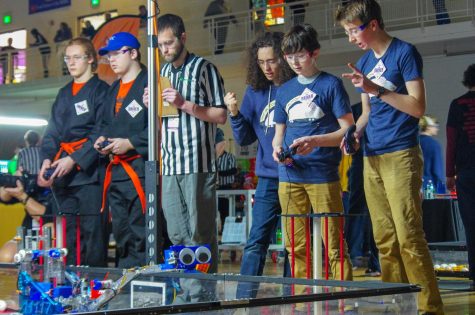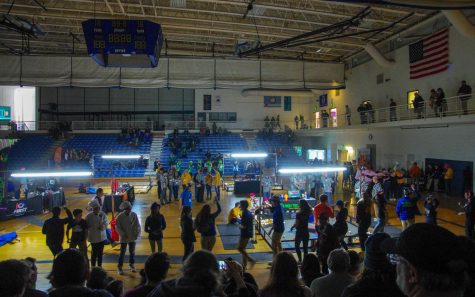Robotics posts solid results at state, fails to make worlds
This past Saturday, the SPA robotics team, known as the Autonomice, ventured to Washington Technology Magnet School in order to pit their robot against the best robots from around the state. The task that students programmed the robots to do differed from event to event. Sometimes, the students would be allowed to control their own robots to complete tasks, but other times, students had to let their robots run completely autonomously. One of the Autonomice co-captains Gabriel Konar-Steenberg, attempted to explain everything their team had to for both the robots they had to control themselves and the autonomous robots.

John Hall, Hayden Graff, and Gabriel Konar-Steenberg control their robot.
“For the autonomous period, we programmed the robot to lower from the lander, navigate to the sampling field (a line of two white whiffle balls and an orange cube), find which one is the cube using computer vision, hit the cube, deposit our “team marker” in one corner of the field, then go park partially on some terrain in another corner of the field,” Konar-Steenberg said.
“For tele-op [where students control their robots], we programmed the robot to respond to the drivers commands; we also included some enhancements like an arm piece that would automatically stay in the same place if the drivers didn’t tell it to move,” he added.
Each of the four tasks Konar-Steenberg described in the autonomous period gets a certain number of points, awarded by completion. In tele-op, you can get points by putting the whiffle balls and cubes into specific areas and by reattaching to the lander at the end. Unfortunately, the Autonomice were not able to accumulate enough points, which would’ve sent them to the world championships, but they found success in other areas.
“The Control Award, which is the one we won for programming, didn’t advance us to the world championship, but the Inspire Award, which is for teams who do really well in every category, would have,” Konar-Steenberg said, speaking to his team’s successes.
This means the end of season for the Autonomice, and although it ended earlier than they liked, Konar-Steenberg was enthusiastic about what the team was able to accomplish. SPA’s robotics team manages a library of code called the HOMAR FTC Library. HOMAR stands for Holonomic Omniwheel and Mecanum, Autonomy, and Response, and Konar-Steenberg along with senior Michaela Polley were able to successfully curate the data to the point where other teams were using it.

The teams from around the state gathered in the gym at the end of the tournament to do awards.
“So far we know of at least 6 other teams that used it this season,” Konar-Steenberg said.
“I think it’s cool because we found a way to use our coding skills for more than just the single task of controlling one robot in one season. This way we help other teams, are able to further our knowledge, and (it turns out) win awards,” he added.
Their coach, Kate Lockwood, the Director of Computer Science and Engineering, enjoyed watching her team progress throughout the season.
“I think the team has really grown a lot over the season. They’ve really come together and learned how to work together as a team. They overcame some really big obstacles, and were able to quickly fix problems that happened in the middle of their periods. They ended up with a competition I think they should be really proud of,” Lockwood said.
They ended up with a competition I think they should be really proud of
— Kate Lockwood
“At this competition, their autonomous [robot] worked consistently for the first time all year, which I think was pretty amazing,” Kirsten Hoogenakker, the US Design and Innovation Specialist who co-coaches the robotics team said.
“Next year, I think we should working on speeding up the design cycle so that we have prototypes that we can test sooner. I think a lot of the problems we ran into this year were just we didn’t realize something wasn’t working until late in the season or at a competition,” Lockwood said, speaking about what the team could do differently next year.
Although at the moment the robotics team is small, they hope they are able to gain more students in the coming years for a stronger team.
“I think people that are interested in joining should come see a competition like this one. People would realize it’s not just your typical techy type kid that does these competitions because there are all types of kids here. There’s something for everyone, the way the competition is structured,” Lockwood said, speaking to what she would say to those that are thinking about trying robotics.
Kelby Wittenberg is the Rubicon News co-editor at RubicOnline. This is his fourth year on staff. He enjoys RubicOnline because he believes news is the...